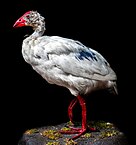Wikipedia:Today's featured article/June 8, 2022
The white swamphen (Porphyrio albus) was a rail found on Lord Howe Island, east of the Australian mainland. All contemporary accounts and illustrations were produced between 1788 and 1790, when the bird was first encountered by British ship crews. Today, two specimens exist: one in World Museum (pictured) in Liverpool, England, and the holotype in the Natural History Museum of Vienna. It is thought to have been most similar to the Australasian swamphen. The white swamphen was 36 to 55 cm (14 to 22 in) long. Contemporary accounts indicate that individual bird plumage was white, blue, or mixed blue-and-white. The bird's bill, frontal shield and legs were red, and it had a claw (or spur) on its wing. It was probably either flightless or a poor flier; this and its docility made the bird easy prey for visiting humans, who killed it with sticks. Reportedly once common, the species may have been hunted to extinction before 1834, when Lord Howe Island was settled. (Full article...)

